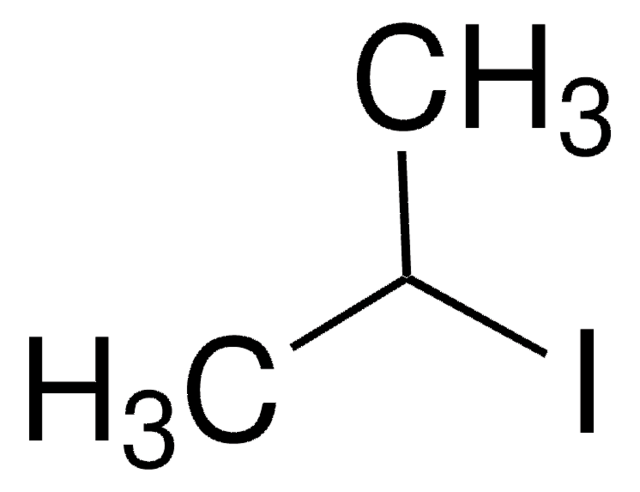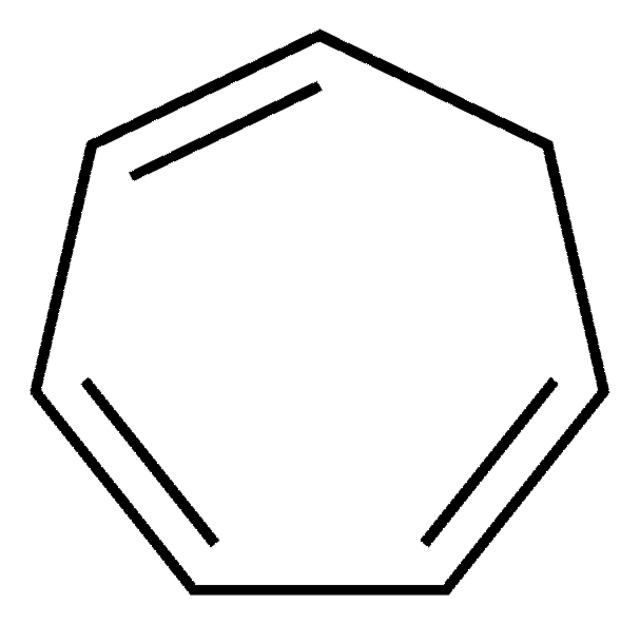296988
Octane
anhydrous, ≥99%
Sinônimo(s):
n-Octane
About This Item
Produtos recomendados
grau
anhydrous
Nível de qualidade
densidade de vapor
3.9 (vs air)
pressão de vapor
11 mmHg ( 20 °C)
Ensaio
≥99%
forma
liquid
temperatura de autoignição
428 °F
Lim. expl.
6.5 %
Impurezas
<0.002% water
<0.005% water (100 mL pkg)
resíduo de evaporação
<0.0003%
índice de refração
n20/D 1.398 (lit.)
pb
125-127 °C (lit.)
pf
−57 °C (lit.)
solubilidade
ethanol: soluble(lit.)
densidade
0.703 g/mL at 25 °C (lit.)
cadeia de caracteres SMILES
CCCCCCCC
InChI
1S/C8H18/c1-3-5-7-8-6-4-2/h3-8H2,1-2H3
chave InChI
TVMXDCGIABBOFY-UHFFFAOYSA-N
Procurando produtos similares? Visita Guia de comparação de produtos
Descrição geral
Aplicação
- A photonic crystal material for the online detection of nonpolar hydrocarbon vapors.: Research on a novel photonic crystal material aimed at the efficient detection of nonpolar hydrocarbons such as octane, enhancing safety and monitoring in chemical processing environments (Bolshakov et al., 2022).
Embalagem
Outras notas
Informações legais
Palavra indicadora
Danger
Frases de perigo
Declarações de precaução
Classificações de perigo
Aquatic Acute 1 - Aquatic Chronic 1 - Asp. Tox. 1 - Flam. Liq. 2 - Skin Irrit. 2 - STOT SE 3
Órgãos-alvo
Central nervous system
Código de classe de armazenamento
3 - Flammable liquids
Classe de risco de água (WGK)
WGK 2
Ponto de fulgor (°F)
55.4 °F - closed cup
Ponto de fulgor (°C)
13 °C - closed cup
Equipamento de proteção individual
Eyeshields, Faceshields, Gloves, type ABEK (EN14387) respirator filter
Escolha uma das versões mais recentes:
Já possui este produto?
Encontre a documentação dos produtos que você adquiriu recentemente na biblioteca de documentos.
Os clientes também visualizaram
Protocolos
Separation of Hexane; Heptane; Octane; Nonane; Decane; Undecane; Dodecane; Tetradecane; Hexadecane; Octadecane; Eicosane; Tetracosane; Octacosane; Dotriacontane; Hexatriacontane; Tetracontane; Tetratetracontane
-1,3-Dimethylcyclopentane; 1,1-Dimethylcyclopentane; 2,2,3-Trimethylpentane; 2,2-Dimethylbutane; 2,2-Dimethylhexane; 2,2-Dimethylpentane; 2,3-Dimethylbutane; 2,3-Dimethylhexane; 2,4-Dimethylheptane; 2,4-Dimethylpentane; 2,5-Dimethylheptane; 2-Methylhexane; 2-Methylpentane; 3,3-Dimethylpentane; 3,4-Dimethylhexane; 3-Ethylpentane; 3-Methyloctane; 4-Methylheptane; Ethylbenzene; Ethylcyclopentane; 2,6-Dimethylheptane; 3-Ethylheptane
-Xylene; Nonane; Propylbenzene; Mesitylene; 1,2,4-Trimethylbenzene; 1,2,3-Trimethylbenzene; 1,3-Diethylbenzene; 1,4-Dimethyl-2-ethylbenzene; 1,2-Dimethyl-4-ethylbenzene; Durene; 1,2,3,5-Tetramethylbenzene; 1,2,3,5-Tetramethylbenzene; 2-Methylnaphthalene (β)
Nossa equipe de cientistas tem experiência em todas as áreas de pesquisa, incluindo Life Sciences, ciência de materiais, síntese química, cromatografia, química analítica e muitas outras.
Entre em contato com a assistência técnica















